#bushfire nation of the world
Explore tagged Tumblr posts
Text
I was going to let this go, but I can't stand it anymore.
What is UP with Evilive and Australia???
(This is a joke btw and not at all serious I love this show)

Okay, so I haven't heard of an 'E2' class Australian visa. No big deal. But it made me curious as to what it was, so I briefly looked for information on what visas Australia had in 2008 and...I couldn't find anything referencing an E2 visa for someone emigrating from South Korea to Australia. What I can find is an E2 class visa for someone emigrating from Australia to South Korea. I can also find an E2 visa for someone emigrating to the US.
So: 1. I'm dumb and missed something. 2. The writers were familiar with E2 visas because South Korea has them, and the US has them, so like...who would notice?
(Side note: They are emigrating to Sydney!!! Whoo NSW representation!!!)
But this...this was what broke me:
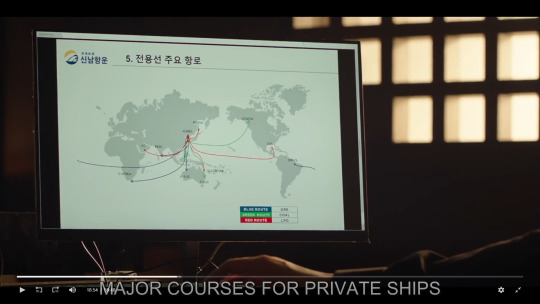

???
??????
Okay. So, you're exporting to...Sydney? Maybe? Sure, lets go with that because literally nothing else makes sense (except Newcastle??? Which has a major port, apparently). And then bypassing Brisbane to ship to...Gladstone, Queensland? Okay, sure. I googled it and they seem to...export a lot of stuff, and have a major port there, so maybe they import too?
And then...what.
Where even IS that in WA (Western Australia)???
Oh! I looked it up and it's most likely Port Hedland, which is apparently another major port! The largest bulk...export...port in the world, supposedly. But maybe they import as well? (Okay, so it DOES import, but wow the difference between the import and export numbers is...a lot. Wikipedia even has 2008 statistics. Neat!)
Wow, the attention to detail sure is great in this show, but...uh...
Why???? Coal????
Why are you shipping our major export, that we export to you, our #3 export market in 2008...back to us?????
Like...it's just about the only thing we do. We export coal. I learned about our coal industry in school. Our richest person is a billonaire mining magnate. One of our former Prime Ministers became a joke for saying, "Coal is good for humanity." And then my university lecturer for Environmental Law got so pissed she put the quote in our final exam as an essay question.
But I digress.
I still looked it up to see if we import coal and export it, and the answer is...no. We do not.
LNG and ORE are also unlikely, as they're some of our other major exports (well, Iron Ore is). I can't find a lot of data from 2008 specifically, but the 2016-2019 data isn't good (compare imports on pages 52-53 with exports pages 54-56) and it seems recently (2021-2022) our major imports from South Korea included refined petroleum and cars. Not Ore and LNG. However, despite being the #1 exporter in the world for Iron Ore in 2021, we were the #42 importer of it too, so that one's possible imo. LNG though? Not as likely as ORE, because we export it and seem to supply it domestically, but way more likely than Coal.
Conclusion?
For a scene that barely lasts 2 seconds, the level of detail is crazy. I'm genuinely very impressed.
Also. It is hilarious that Seo Do Young was planning to sell us coal. The end.
#evilive#evillive#biography of a villain#PS it's VEEEERY funny that Han Dong Soo's arsonist mother#was going to come to Australia of all places#bushfire nation of the world#AND IN 2008#like my guy you should be soooo glad you stayed in South Korea actually#PPS I couldn't figure out was 'WA US' and 'EA US' meant#and I JUST realised it means 'West Australia' and 'East Australia'#West Australia and East Australia and GLADSTONE#I'm deceased
9 notes
·
View notes
Text
Focusing on wildfire prevention and management.
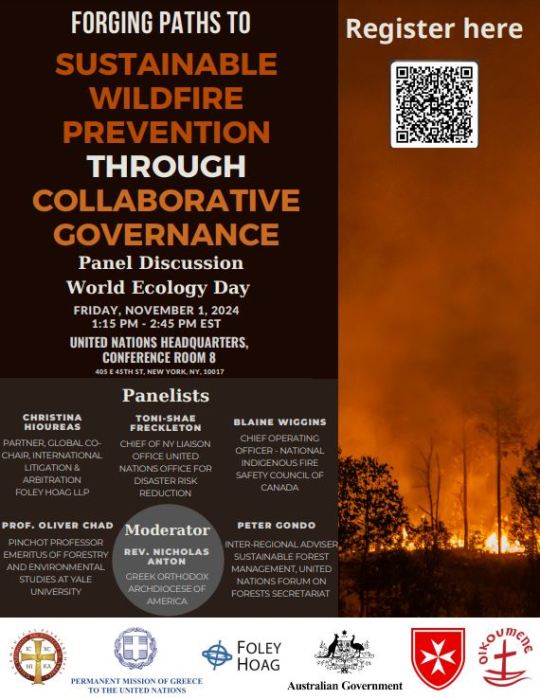
In light of this growing crisis, we are organizing a side event on November 1st, World Ecology Day, focusing on wildfire prevention and management under this year’s theme of environmental protection and sustainability. Recent studies and events, including the UN’s Department Economic and Social Affairs (DESA) Policy Brief #111, highlight the need for comprehensive strategies that integrate scientific, traditional, and policy-driven approaches to wildfire management. Get the flyer!
#wildfire#united nations department of economic and social affairs#comprehensive strategies#panel discussion#wildfires prevention#frequency and severity of wildfires#wildfire management#capacity building#adaptative management#restorative activities#bushfire#1 november#world ecology day#ecological and hydrological connectivity#ecological restoration#decade on ecosystem restoration#sustainable practices#environmental protection#sustainability
0 notes
Note
I just spent some time scrolling through this blog and am suffering from sever laughter. Thanks so much for collating the countries craziest moments. One of my favourites is when Scott Morrison was in Hawaii while the bushfires where burning.
December 2019: As Australia's east coast is engulfed in the worst bushfires in living memory, rumours begin to circulate that Australia's Prime Minister Scott Morrison may have secretly fucked off for a holiday in Hawaii.
Keep in mind, this is what is going down in Australia at the time:
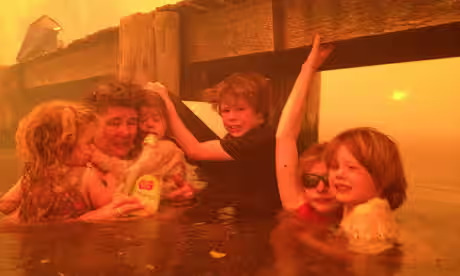
The Hawaii rumour is initially written off as a fringe conspiracy, because surely nobody could be that fuckin tonedeaf, and it was quickly forgotten about... until an Australian man visiting Hawaii UPLOADED A SELFIE ON THE BEACH WITH THE PM THROWING A SHAKA.
At which point all hell broke loose.

Overnight the formerly popular "Scomo" became the most despised man in all of Australia. Think "firefighters shouting out of their windows to news cameras" level of despised.
After about two days of radio silence and pretending like he was still at home running the country, the Prime Minister's handlers finally dragged him onto call with an Australian radio station, where he pinky promised to return to Australia as fast as he could in an attempt to calm things down.
Unfortunately Scott's empathy consultant (a real job) then had to watch Scott pour more gasoline on the dumpster fire by uttering the now famous phrase "Look I don't hold a hose mate" when asked by the radio interviewer why the fucking fuck the fuckhead wasn't fucking in Australia doing his fucking job during a massive fucking crisis.
Testing just how much worse things could get, Scomo then proceeded to NOT rush back to Australia as promised, instead attempting to complete the rest of his holiday, a fact that was exposed when a passerby snapped a picture of him still lounging on the beach two days later.

Eventually, holiday complete, Morrison did reluctantly slink back to Australia, and in an attempt to calm things down, he decided to pay a visit to a small town that had been destroyed by the fires.
Which was a big mistake.
Scomo still had not registered how absolutely and totally he had screwed the poodle with his Hawaiian beach vacation, and he walks into what is now taught in PR classes as one of the greatest examples of "what not do do in a crisis" in all of history.
Scotty from Marketing, as he is now dubbed by the nation, spends a painfully cringe-inducing hour wandering around a burned down town with TV news cameras in tow, having to FORCE PEOPLE TO SHAKE HIS HAND in what is some of the most awkward footage you will ever see.
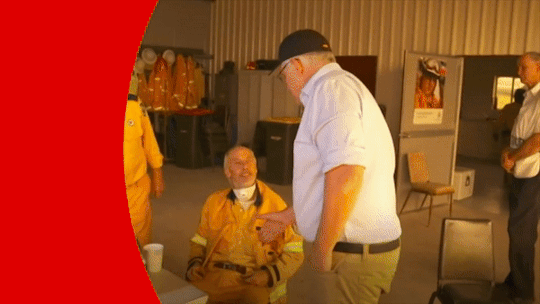
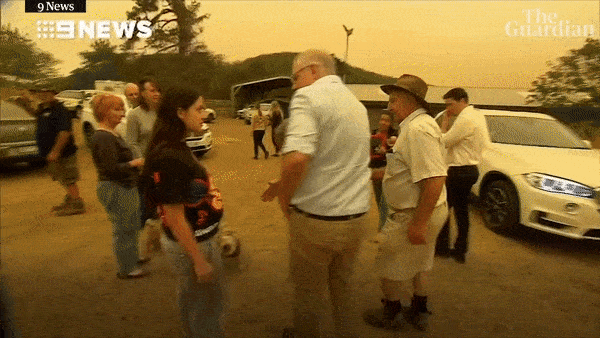
At this point it's probably also worth mentioning that, before becoming Prime Minister, Scott Morrison's biggest claim to fame in politics was being the guy that was so far up the coal lobby's arse that he literally brought coal into parliament and waved it around, claiming it doesn't hurt people.
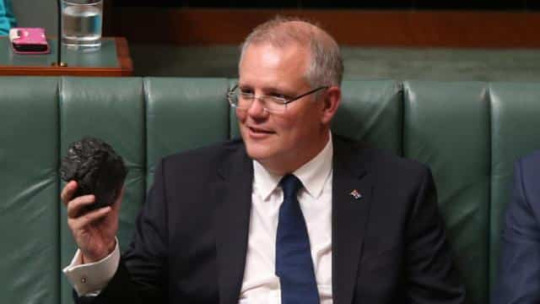
So when a protest was organised it turned out to be one big national fuck you to the Prime Minister, the likes of which the world has never seen before or since.
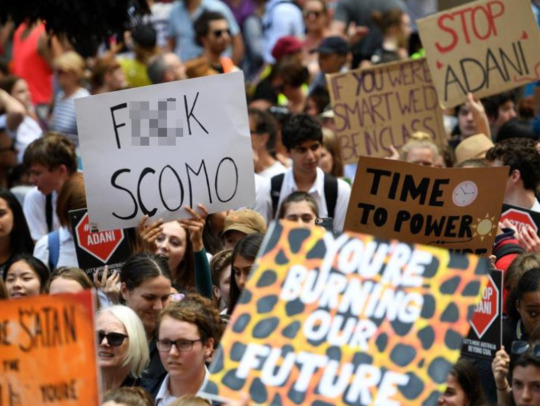


Needless to say, at this point Scomo's career was dead in the water, but thanks to the rules brought in to stop Australian political parties from knifing their leader every two weeks (a popular Aussie passtime) Morrison basically couldn't get fired until after the next election.
And so, when the election rolled around in 2022, we decided that was an opportune time to travel over to Hawaii to erect this bad boy tribute to the Prime Minister, on the very beach where Scomo had sat and drank margaritas that one fateful week in December as Australia burned (thanks to @chaser for funding the ticket)
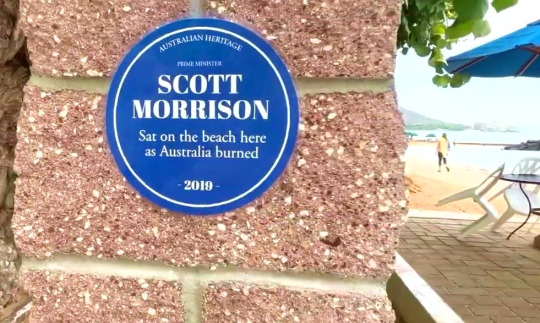
9K notes
·
View notes
Text
(yesterday i received an ask, which prompted me to write the following response. the asker has apologised for sending it and i took it down to prevent anyone from laying into them, but present is anonymously below because i like my response and want you to see it)
"Based on the fun new revelation that the world is ending before I graduate, is it even worth it to try prepping or should we all just get ready to jump into traffic come 2025?"
okay, there is, A LOT to unpack here. i'm gonna do my best to respond to this helpfully, the way i am facing it: confronting it, emotionally processing it, pragmatically preparing, and holding on to a sort of grim, dark hope.
we're talking about climate collapse and the latest IPCC report here right? first off, it's not a new revelation. maybe it is for you personally, but for humanity as a whole, we've known about the inevitable outcomes of emissions damaging the climate since like the 70's. i found out about it myself in primary school in the mid 90's, when it was still called the greenhouse effect, and i then spent 20 years on and off in various roles of support for climate activism, when i had the spoons. if you're young and just finding out about it now i know it's probably overwhelming, and especially sucks the later you've been born into this mess… but i'm pointing out that it's not new, to underline the point that it's also not sudden. yeah it's getting worse, but it's been getting worse for generations, and will keep getting worse for generations.
it's not a meteor, or a volcano. it's a creeping steady decline of habitability with sputters and bursts of natural disaster; there is no timeline or event or threshold at which the world ends here.
that 2025 "deadline" from this year's IPCC synthesis report, for instance; it's not a date that the world ends. honestly, in some ways, it's kinda meaningless. what it is, as i understand it, is that all the data says that if we want to limit global average temperature rises to 1.5C by end of century - which we do, because even 2C would be catastrophic - we need emissions to peak by 2025 and then rapidly decline. it's a vastly oversimplified agregate of incredibly complex data reduced down to the point of absurdity in a desperate attempt by scientists to get corporations to allow governments to take action to limit corporations. it's a deadline for government action to limit effects by 2100. the year will come, and pass, and the world will go on. probably with emissions still going up, probably with targets shifted again and 2C accepted as the next half hearted goal that will also be missed, but life will go on.
no end of the world. life will go on. into the 2030's, into the 2040's, into the 2100's, life will go on. it'll be hotter and colder, wetter and drier, more storms and bushfires, less food and fertile land, but life will go on. populations will starve, land will become uninhabitable, life will go on. when you hear about "the end of the world" from climate collapse, it's not a hard apocalypse that kills us all off or whatever. it's the slow creep of nature getting more harsh, and the way we do things much harder.
if you look at the serious reports from scientists and militaries, the language you see isn't "end of the world", it's "end of modern societies". that's what's really at risk: the fragile infrastructure that holds up the ruling classes of rich nations and has us all scurrying around to make it work. mass scale power grids, international supply chains and just in time logistics, silicon wafer production, year-round plastic wrapped preserved passionfruit chunks grown in thailand, packed in argentina, sold in france, profits to america, money stored on a computer in the cayman islands. i can't sugarcoat it and say that's all that's at stake; people are definitely going to starve and drown and die of exposure; but that already happens every day in most of the world, right now. there are a million rohingya at the border of bangladesh, locals fleeing khartoum as the west airlifts out is nationals, people whose civilisations were crushed under the boots of empires and land destroyed to create the farmland and factories that are killing the planet. life for them goes on.
i mean, i get it. seeing the impending collapse of your society, everything you've known for your whole life being willfully destroyed, it's fucking devastating. we want to keep sitting here on comfortable couches with our gold and cobalt plated supercomputers sharing cat gifs on the hellsite. we don't want to have our civilisation taken away from us and be forced into brutal struggle to survive. it's going to fucking suck, it will be awful, and it will be (and already is) most destructive to the people who are already the worst off, which just sucks even more… and maybe your life is already bad enough that you don't think you can handle it getting worse. i mean, i've been suicidal since i was 14 and i've been through trauma and medical torture you wouldn't believe since then. i get it. you're scared, terrified even. existentially threatened. you don't know what you can handle and maybe you donn't wanna find out.
but here's the thing: the ONLY sensible thing you can do, now and going forwards, is prepare for it.
you wanna kill yourself when it gets hard? let's say sure, i agree with that. what's the threshold then, what's the limit? when will you kill yourself? the power grid going down? sewerage backing up? supply chains failing and being unable to buy food? from the comfort of the developed world, those all feel like exit points i can imagine many people taking as their out… but how long does it have to last before you know it's carbon-monoxide-party time? a month of no power, no flush, no food? a week, a few months, or a year? because it won't start that way.
it's not a meteor or volcano, it's a slow slide. some powerlines sagged so there's rolling blackouts every now and then, a few hours or a day at a time. pipes backed up a bit so pressure is reduced for a week until repairs are done. fires and plague have closed roads so shelves are bare and stores are limiting purchases on essentials this month. there will be bumps along the road before there will be any sort of definitive cliff where you can say "this is it, now is the time to kill myself". these bumps are already happening.
i really hope you can agree, it'd be absurd to be such a fatalistic doomer that you kill yourself instantly at the first blackout, dry tap, or closed grocery store; when you can't know if it'll be back up in a few hours or tomorrow or next week. these small disruptions are already happening right now, directly as a result of climate collapse, but we're still here, still living. if we're going to talk about suicide as a pragmatic option, you need a threshold, and wherever you set it, you'll have to get through what comes before. "i'll kill myself after a month with no grid" still means you gotta be ready for a week without it. you gotta prepare, even if you plan to not survive.
and i know it's overwhelming, i know. to look around and think about what is essential to keep you going, what you can sacrifice, how you can make it through. but you're not going to be doing it alone, everyone around you is going to be doing it with you. we're all going to be struggling through it, and based on how communities have responded in the last few years to a string of once-in-a-lifetime disasters here in my home of climate-fucked australia, i am certain that when the climate collapses around a group of people, they will form a community and help each other, no matter how selfish and mean of a country bogan (translation: redneck) they are. people will help each other; people already are helping each other.
because yeah, climate collapse will probably destroy modern civilisation… but so what? it's a neoliberal capitalist hellscape quickly plunging us into technologically enforced eternal authoritarianism… and like, not to be an accelerationist or anything, but here's that dark hope i mentioned: i'm kinda relieved by the thought that the infrastructure that enables it won't last this century. that climate collapse will force us out of these horrors, and back into real, interdependent community.
so do what you can to prepare, how you can, to make the little disruptions more bearable and comfortable. there's plenty of resources still available for off grid life, camping, home agriculture, and general self sufficiency out there on the still-existant internet, and more people are getting into it all the time - not just what you imagine when you hear "prepper". any skill you can develop, anything you can do to prepare, even if it's as simple as keeping extra shelf stable food and a jug of clean water around, anything you can do will help you materially and more importantly, mentally.
having some jerry cans of water and a small solar setup has been amazing for my mental health and anxiety! and as much as i'm putting material and energy into preperations, i'm also putting them into comfort, maybe even hedonism. collecting some cool lego, got some fancy synths i didn't need, making fucked up noise music with them. enjoying the sound of the neighbours' chickens, looking forward to the day "the world ends" and i can free-range my own on the council's nature strip and share the eggs with the pottery lady down the street. once you're prepared to survive a week of grid down, maybe you'll realise a month, a year, isn't so unbearable. maybe it starts to feel nice?
because i've been there, the suicidal grief. 2018 was absolutely the worst year of my life and i was sure i'd die being tortured in hospital, and coming out of that, in 2019, both the IPCC and ADF released incredibly bleak reports on climate collapse outcomes, and it all sank in. all the spare spoons i'd sunk into helping when i could, all the decades of scientists desperately warning, it all failed. the final warnings have been coming for years, with no change in course, it's happening. and i faced the realisation that my decades were limited, my time of comfort short, and i started despairing and grieving. i turned to what support systems i had, and they failed me. when my psych asked what i was so anxious about and i started explaining the climate reports, he tensed up and started asking diagnostic questions for dilusional psychosis. i went home and cried, i was sleeping on the couch in the junk storage room of my sharehouse because i'd let my own room fill up with so much trash that there was a distinctly organic smell of growth choking the whole place out. i was fucking done, my heart and body broken, there didn't seem to be any point in anything, not without a future. it's the closest i've been to killing myself since leaving home…
so i said, fuck it. i've got a tiny pool of cash from welfare backpay, and i bought a synth i wanted. it fucking rocked, and brought me so much joy, so i bought another, and another. no future to save for, anyway. i made some cool music, i never saw that psych again, i gave up on my drive for revenge on doctors and finding answers about my fucked up nervous system, why bother when the world is ending? and i made music. i can kill myself later maybe. i started loving myself more, because what's the point starving to death hating myself? i made music and got confident and cleaned my fucking room, bought a new mattress. i met a girl and took a chance and we fucked real good and i fell in love again. i moved out somewhere new and quieter and left a home of over a decade behind me, left parts of my identity behind me, moving forward and growing for the better. i have a family now, the first family that has ever loved me without expecting anything in return, and i love them with all my heart. i listen to the chickens, and watch leaves float down the storm water drain, and make cool music. yesterday i listened to a 14 minute track i made 6 months ago and almost cried, because nobody can make music that is so perfect for my tastes except me, and i brought it into existence. on the weekend i'm gonna set up the solar panel to keep the backup battery topped up, i use it to charge my phone and laptop, which the kids would call solarpunk and i'd call cool as fuck to have a solar powered laptop.
in 2019 i stared into the void and realised there is no real future for me, for human civilisation as we know it, and i grieved and processed… i almost killed myself, but i didn't, and the years since have been the best of my life, no question.
so, no. don't kill yourself, now or in 2025 or at any point until you can't handle the torture anymore. "graduation" sounds young, real young, even if it's tertiary. i'm creeping towards 40, and the age that "graduation" conjures makes me think that you've got a hell of a lot of potential left in you, for fun and stupidity, and growing up, and finding love and heartbreak, and your version of wierd-arse synth music.
so go out there, prepare, and enjoy.
…
…..and for the love of all the false goddesses of the void, never, NEVER EVER again contact a random fucking blog on tumblr and ask if you should kill yourself. holy fuck buddy. the amount of pressure you put me under to deliver an emmaculately worded response that somehow talks you down from the ledge without lying, is way, way too much fucking pressure. i really hope you were being stupidly hyperbolic, but even then, Eris Fucking Kallisti Herself In Absurdist Pagan Blasphemy, so incredibly unacceptable to say to a stranger. i think you need a therapist, even if they do think you're catastrophising, because like. shit dude. this is abso-fucking-lutely not okay!
now go. prepare and enjoy.
300 notes
·
View notes
Text
'Save the queen': Priscilla, Queen of the Desert bus found
New Post has been published on https://qnews.com.au/save-the-queen-priscilla-queen-of-the-desert-bus-found/
'Save the queen': Priscilla, Queen of the Desert bus found
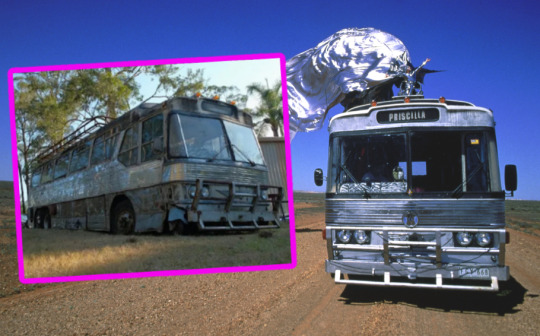
After 30 years, the original bus from The Adventures of Priscilla Queen of the Desert has been found and will undergo an extensive restoration for permanent inclusion in a museum.
Priscilla is celebrating its 30th birthday this year. The film premiered in 1994 and later became not just a queer classic but a crossover sensation. The film won an Oscar for its iconic costumes.
Now the History Trust of South Australia has started a campaign as it takes on a massive restoration job to restore the bus.
The trust has bought Priscilla, a 1976 Hino Freighter bus, after she was discovered in a paddock of a property in the town of Ewingar in the Northern Rivers Region of New South Wales.
Director Stephan Elliott said after filming ended, nobody knew where the original Priscilla ended up.
But for the last 16 years, she’s resided in the country town, left to the elements and falling into disrepair.
Somehow, the bus escaped without extensive fire damage following bushfires in the area a few years ago.
Stephan Elliott ‘gave up hope’ of finding bus
Stephan Elliott has backed the History Trust’s plan to “save the queen” and restore Priscilla.
“We had heard so many rumours about where she had ended up. We had given up hope of finding her again,” Stephan explained.
When the owner of the Northern Rivers property contacted the History Trust of South Australia, everyone had to know, was it really Priscilla?
The Trust’s curators went to find out. Stephan Elliott confirmed the authenticity of the bus by identifying remnants of the interior decor.
“I really want to thank the History Trust for making this amazing discovery and bringing Priscilla back to life,” Stephan said.
“The film seems to carry through generations. This is a chance for possibly many more generations to feel its message of love, tolerance and living your true self every day.”
Priscilla’s restoration will take at least 12 months
Now, Priscilla is in Queensland. A specialist coachwork repairer in Brisbane is finalising the scope of the restoration works.
The History Trust of South Australia expects Priscilla’s repair and restoration to take 12 to 18 months.
They’ve called out for donations in addition to support for the project from the South Australian government.
Once restored, Priscilla will make herself at home in Birdwood’s National Motor Museum. The museum is planning an immersive exhibition on the film’s cultural and social impact.
History Trust of South Australia CEO Greg Mackie said in 1994, Priscilla was “released into a world still grappling with the impact of HIV/AIDS”.
“It immediately became a symbol of survival, the importance of love and respect, and of embracing of difference,” he said.
“The History Trust of South Australia intends to restore Priscilla to roadworthy condition for special outings, and to authentically render to its interior the glamorous over-the-top camp of the 1994 movie.
“Even in the 21st century, The Adventures of Priscilla, Queen of the Desert speaks to audiences of the virtues of respect for diversity and the great Aussie larrikin tendency for irreverence.
“Priscilla Queen of the Desert has earned the affectionate regard of a majority of Australians over the last 30 years by affirming the place of road adventures in our national culture.
“Where better for this icon than at Australia’s National Motor Museum?”
youtube
More on Priscilla:
Broken Heel Festival is celebrating Priscilla’s 30th birthday
‘They booed’: Stephan Elliot recalls horror first Priscilla screening
‘Hire locals’: Outrage over RuPaul’s Drag Race stars’ Priscilla shoot
For the latest LGBTIQA+ Sister Girl and Brother Boy news, entertainment, community stories in Australia, visit qnews.com.au. Check out our latest magazines or find us on Facebook, Twitter, Instagram and YouTube.
20 notes
·
View notes
Text

It's been a little while since I've attempted any fundraising, but I've just become aware that the Royal Zoological Society of Scotland is preparing to release its first group of Scottish Wildcats from their breeding for release program back into the Cairngorms National Park! This is a project I've been interested in and given support to since I visited Scotland some years ago and was able to see some (non-releasable) cats myself, as well as drive through the wilderness that should be their home. Not only is this incredible milestone imminent, but they're currently running a fundraising drive to assist with this program, and Big Give's Green Match Fund is doubling any funds received until the 27th!
So, much as I did to help the bats affected by the Australian bushfires back in 2020, I'd love to offer some little sketchbook scribbles for anyone so inclined and in a position to give a little to this cause. If you donate any amount to Saving Wildcats through Big Give at any point over the next three days, let me know about it (pm, discord, email a screenshot of your donation, no need to have any real-world identifying details attached), and Ahuska will sketch something for you in thanks- whether it's a beloved character of yours, a favourite creature or cherished pet, you name it!
35 notes
·
View notes
Text

https://www.reuters.com/world/middle-east/israel-allows-un-bring-more-equipment-amid-gaza-lawlessness-2024-07-15/
3 notes
·
View notes
Text
The rain has been ceaseless since last night but I slept well enough. It feels like this place is about to be washed away, pulled back to the ocean from whence we all came. Bushfires last week, flood warnings this week. We're hitting all the major disaster groups at the moment. Next week they'll announce the reawakening of a prehistoric supervolcano in the middle of Australia. Some natural gargantuan that's ready to fuck the country raw and bloody. "God help Australia" The newscasters will proclaim on national television, right before rockets of volcanic rock, basalt, and lava cascade down and shower us all with the freak fury of a fiery earth. Mother Nature always gets her man. The rest of the world be none the wiser state that they never even knew what Australia was until they heard it was wiped off the maps like the sin is wiped from a lover's lips after a night of half-remembered debauchery. Australia, we hardly knew ye'! As it stands, I wait with bated breath, drinking my morning coffee, waiting for my mates to arrive so we can talk about music, music festivals, and shoot the breeze for a while. Good conversation being the ultimate remedy for a cold and soaked spring day. I'd prefer sin and sacrifice, but conversation will have to do.
6 notes
·
View notes
Text
The 2016 Great Smoky Mountains wildfires claimed at least 14 lives, and injured 190 people. The fires impacted the towns of Pigeon Forge and Gatlinburg, both near Great Smoky Mountains National Park. The fires are considered one of the largest natural disasters in Tennessee history.
The 2018 California wildfires had a total of 103 confirmed fatalities. The Camp Fire, which occurred in Paradise, California, killed 85 people and destroyed more than 18,000 buildings. The Camp Fire was the costliest disaster worldwide in 2018. It was also the deadliest and most destructive wildfire in California's history.
The Australian bushfires of 2019-2020 directly killed 33 people and over one billion native animals. The fires also caused 417 human deaths due to smoke inhalation. The fires burned in six states across six months, affecting 80% of the Australian population.
In 2020, 33 people died in California wildfires that burned 4.2 million acres, a state record. This was the third deadliest year for California wildfires since 2013.
Amid the bleakness of 2020, scientists in Brazil concluded a particularly grim conservation study - attempting to count the animals killed by huge wildfires in the Pantanal wetlands. They estimate that as many as 17 million vertebrates - including reptiles, birds and primates - died. Wildfires burned between January and November, destroying 30% of the world's largest tropical wetland.
Five people have died from wildfires in Canada in 2023. The wildfires have scorched at least 11 million hectares, or over 27.1 million acres, of land across Canada this year.
Meanwhile, in Maui, wildfires started on August 8th, 2023 (Now August 15th, 2023).
The death toll from the wildfires on the Hawaiian island of Maui is at least 101 people. The wildfires destroyed the historic town of Lahaina and killed at least 99 people, making it the worst natural disaster in state history and the deadliest U.S. wildfire in over a century. Officials warn that the death toll is likely to rise. Many people remain missing.
None of this is okay, and I'm not trying to compare trauma, but the fact that this disaster is happening right now and I have seen a total of 2 posts about it on my dash is disheartening, to say the least.
P.S. Spread the word. Do not ignore Maui.
3 notes
·
View notes
Photo
This is NOT endemic to the American Salvation Armies! Multiple countries around the world that have a Salvation Army presence often report similar issues, alongside groups such as Red Cross and d other major charities that have become big enough to be a corporate entity.
Around Australia, it is firmly believed that if you want to BUY something that supports someone, go to a charity warehouse when on sale. There are fashion auctions, food auctions, raffles at fetes. If you want something to go to the poor, impoverished and those who can’t look after themselves in any such situation, you either find away to give to a friend, give to a family member, or make the decision to look further into it and put you energy where it will have a result.
(I must say, American Soup Kitchens are impressive for this reason - so much messing about with money and laws and papers, and some guy with a food van pulls up and gives everyone waiting in line for a meal as long as they take a sticker? Amazing. Genuinely impressed by this.)
There are other charities out there, who are honest, and maybe one day they’ll be listed by country in the tags?
Ronald McDonald House (AUS)
The foundation that helps families stay with their sick children for free at associated lodgings near remote or city hospitals. My mother stayed at one for my brother’s entire hospital stay. Maccas may not be the best, but McDonald house is seperate.
Rural Flying Doctor/Royal Flying Doctor/‘Angel Flight’ (AUS/CAN/NZ)
Response personnel for remote areas and emergencies - only some of their groups receive funding from governments. Royal Flying Doctors are the most prestigious, and Angel Flight is considered a ‘private company’ despite being very dedicated to the cause, so supporting them will be a matter of research and helping their volunteer numbers grow.
Rural Fire Service(RFS)/Special Emergency Services(SES)/Rural Fire Brigade/Volunteer Firefighters (AUS/?)
Very few firefighters are permanent employees, but they will arrive for any and all emergencies. Firefighters will even turn up to riots, crashes, building collapses, live burials and bomb threats. They are the true emergency response. I know some stations have poor attitudes and terrible treatment of staff and civilians, but that is exceedingly rare as Australian relies on the volunteers and not the permanents in times of crisis - see recent bushfire catastrophes, and yes, plural.
For Homelessness, Domestic Abuse, Mental Illness, and Drug related matters, Australia has a variety of possible charities and organisations.
Headspace - youth mental health and support
Beyond Blue - suicide hotline
White Ribbon - Domestic Violence charity, that collated the national and state support lines, laws, and resources into a specific banner.
Homelessness Australia and Mission Australia - both separate organisations, but both have a goal of either supporting an individual to get them off the streets, give financial advice and support in times of need, and a collation of national and state services and support.
National Drug and Alcohol abuse hotline- gets directed to local services, of which my local regional area has around five rehab centres, and given directions and dialled through to effective doctors and treatments.
Unfortunately, when it comes to international charities, it’s a harder game. And I do not know enough to help you there.
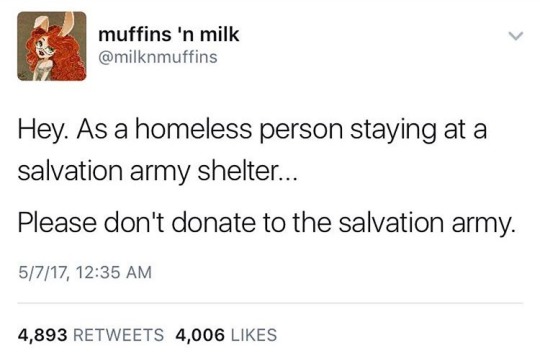

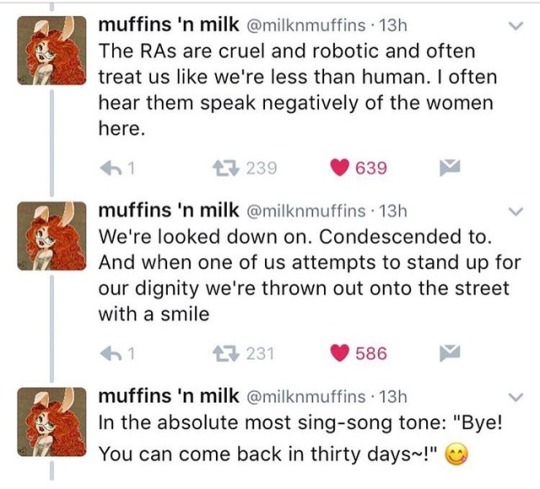
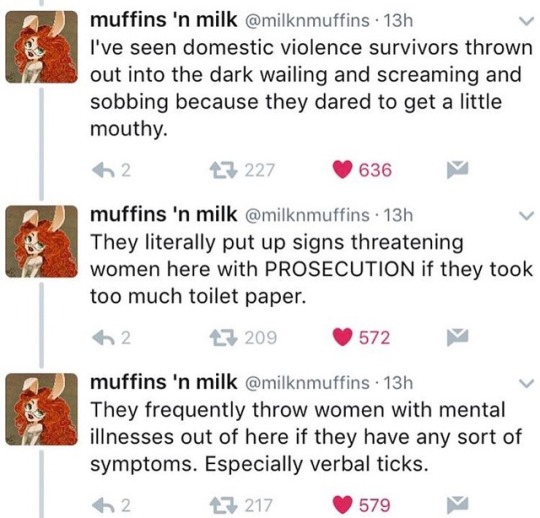


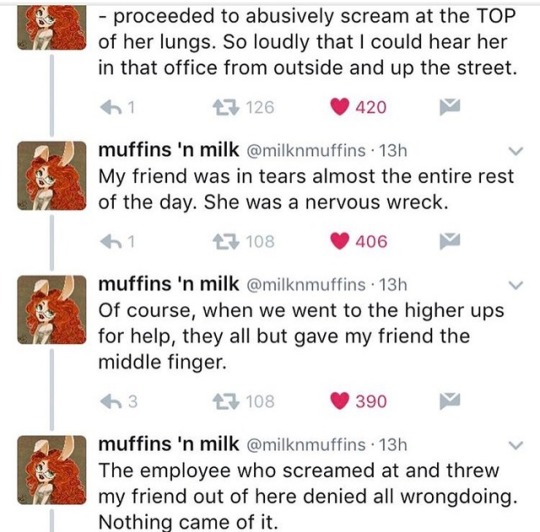
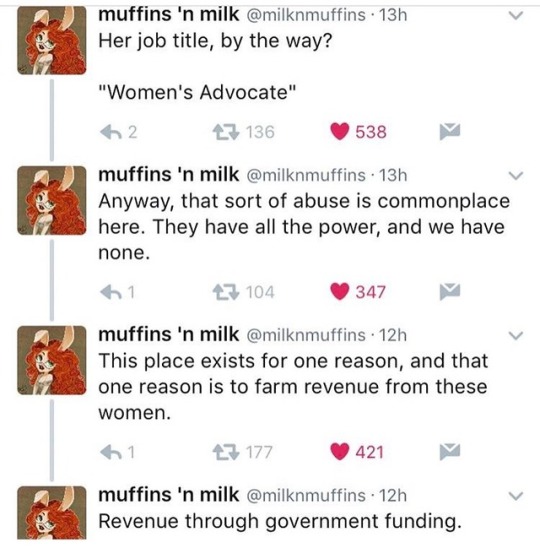
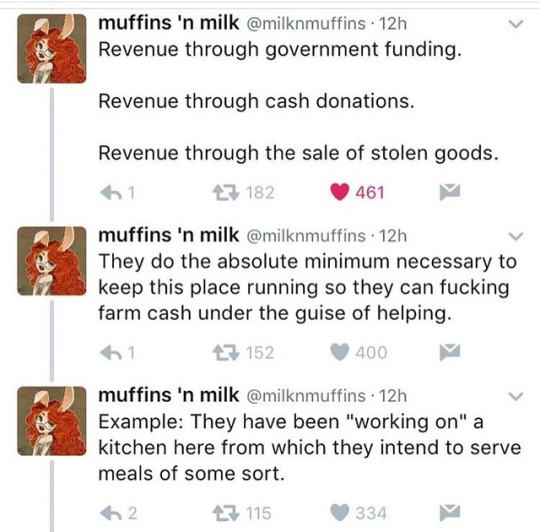

DO NOT SUPPORT SALVATION ARMY
438K notes
·
View notes
Text
Welcome to New World Next Week – the video series from Corbett Report and Media Monarchy that covers some of the most important developments in open source intelligence news. This week:
Video player not working? Use these links to watch it somewhere else!
WATCH ON: / / / / / or DOWNLOAD THE MP4
Story #1: How Wokeism Created the L.A. Wildfire Crisis https://pjmedia.com/matt-margolis/2025/01/08/how-wokeism-created-the-la-wildfire-crisis-n4935802
Army Approves Reduced Physical Fitness Standards For Women, Older Soldiers https://thehill.com/policy/defense/599459-army-approves-reduced-physical-fitness-standards-for-women-older-soldiers/
Trump Blames Democrats for Protecting ‘Useless Fish’ Over Water for LA Fires; Donald Trump and Elon Musk Hit Out at Political Rivals Over the Blazes, Which Experts Have Pinned on High Winds and Low Rainfall https://www.telegraph.co.uk/us/news/2025/01/09/democrat-policies-not-climate-change-blame-la-wildfires-usa/
#MorningMonarchy: January 13, 2025 – Burning Down Diversity Boulevard https://mediamonarchy.com/20250113morningmonarchy/
Israel, Hamas Agree to Gaza Ceasefire and Hostage Deal https://www.cnn.com/world/live-news/israel-hamas-gaza-ceasefire-hostages-01-15-24/index.html
Interview 1514 – Jo Nova on the Australian Bushfires https://corbettreport.com/interview-1514-jo-nova-on-the-australian-bushfires/
California Insurer Canceled Policies Months Before Los Angeles Wildfires https://www.newsweek.com/california-insurer-canceled-policies-months-before-los-angeles-wildfires-2011521
Story #2: National Review Prevails Against Michael Mann https://www.nationalreview.com/news/national-review-prevails-against-michael-mann/
Mark Zuckerberg Praises ‘Masculine’ Corporate Energy Amid Meta’s DEI Policy Reversal https://www.huffpost.com/entry/mark-zuckerberg-meta-masculine-corporate-energy-joe-rogan_n_6781edb5e4b0785f3ce57111
Pay Up, Mr. Mann https://www.nationalreview.com/2025/01/pay-up-mr-mann/
Nichecasting – #SolutionsWatch https://corbettreport.com/solutionswatch-nichecasting/
BlackRock Leaves Major Climate Group Amid Wall Street Exodus https://finance.yahoo.com/news/blackrock-leaves-major-climate-group-194831466.html
The Last American Banker Rats Are Leaving the UN Net Zero Banking Club https://joannenova.com.au/2025/01/the-last-american-banker-rats-are-leaving-the-un-net-zero-banking-club/
From Idealism to Realism https://rogerpielkejr.substack.com/p/from-idealism-to-realism
Story #3: UK Unveils National AI Plan For Change https://www.biometricupdate.com/202501/uk-unveils-national-ai-plan-for-change-ex-pm-sees-digital-id-as-needed-disruption
UK Gov. Report: AI Opportunities Action Plan https://www.gov.uk/government/publications/ai-opportunities-action-plan/ai-opportunities-action-plan
WEF: Technology convergence is leading the way for the fifth industrial revolution https://www.weforum.org/stories/2025/01/technology-convergence-is-leading-the-way-for-accelerated-innovation-in-emerging-technology-areas/
Tony Blair: Digital ID Is the Disruption the UK Desperately Needs https://institute.global/insights/tech-and-digitalisation/tony-blair-digital-id-is-the-disruption-the-uk-desperately-needs
Biden Opens Federal Land to Power-Hungry AI Datacenters https://www.theregister.com/2025/01/14/biden_ai_executive_order/
2025 Predictions https://corbettreport.com/2025-predictions/
The ‘New World Next Week’ Store https://newworldnextweek.com/
0 notes
Text

𝑻𝒉𝒆 𝑮𝒓𝒆𝒂𝒕 𝑴𝒆𝒍𝒃𝒐𝒖𝒓𝒏𝒆 𝑻𝒆𝒍𝒆𝒔𝒄𝒐𝒑𝒆.
𝑩𝒖𝒊𝒍𝒕 𝒊𝒏 1868 𝒊𝒏 𝑫𝒖𝒃𝒍𝒊𝒏, 𝒊𝒕 𝒘𝒂𝒔 𝒊𝒏𝒔𝒕𝒂𝒍𝒍𝒆𝒅 𝒊𝒏 𝑴𝒆𝒍𝒃𝒐𝒖𝒓𝒏𝒆 𝒊𝒏 1869.
𝑨𝒕 𝒕𝒉𝒆 𝒕𝒊𝒎𝒆 𝒊𝒕 𝒘𝒂𝒔 𝒕𝒉𝒆 𝒔𝒆𝒄𝒐𝒏𝒅 𝒍𝒂𝒓𝒈𝒆𝒔𝒕 𝒕𝒆𝒍𝒆𝒔𝒄𝒐𝒑𝒆 𝒊𝒏 𝒕𝒉𝒆 𝒘𝒐𝒓𝒍𝒅, 𝒂𝒏𝒅 𝒕𝒉𝒆 𝒍𝒂𝒓𝒈𝒆𝒔𝒕 𝒐𝒏𝒆 𝒕𝒉𝒂𝒕 𝒘𝒂𝒔 𝒔𝒕𝒆𝒆𝒓𝒂𝒃𝒍𝒆.
𝑨𝒇𝒕𝒆𝒓 𝑴𝒆𝒍𝒃𝒐𝒖𝒓𝒏𝒆 𝑶𝒃𝒔𝒆𝒓𝒗𝒂𝒕𝒐𝒓𝒚 𝒄𝒍𝒐𝒔𝒆𝒅 𝒊𝒏 1944 𝒕𝒉𝒆 𝒕𝒆𝒍𝒆𝒔𝒄𝒐𝒑𝒆 𝒘𝒂𝒔 𝒎𝒐𝒗𝒆𝒅 𝒕𝒐 𝑪𝒂𝒏𝒃𝒆𝒓𝒓𝒂’𝒔 𝑴𝒕 𝑺𝒕𝒓𝒐𝒎𝒍𝒐 𝒘𝒉𝒆𝒓𝒆 𝒊𝒕 𝒘𝒂𝒔 𝒃𝒂𝒅𝒍𝒚 𝒅𝒂𝒎𝒂𝒈𝒆𝒅 𝒊𝒏 𝒕𝒉𝒆 2003 𝒃𝒖𝒔𝒉𝒇𝒊𝒓𝒆𝒔.
𝑬𝒓𝒆𝒄𝒕𝒊𝒐𝒏 𝒐𝒇 𝒕𝒉𝒆 𝑮𝒓𝒆𝒂𝒕 𝑴𝒆𝒍𝒃𝒐𝒖𝒓𝒏𝒆 𝑻𝒆𝒍𝒆𝒔𝒄𝒐𝒑𝒆 𝒂𝒕 𝑴𝒆𝒍𝒃𝒐𝒖𝒓𝒏𝒆 𝑶𝒃𝒔𝒆𝒓𝒗𝒂𝒕𝒐𝒓𝒚, 1869.
History
The Great Melbourne Telescope (GMT) was built by Thomas Grubb of Dublin in 1868 and erected at Melbourne Observatory in 1869. It was a reflecting telescope with a speculum (metal) mirror of 48 inches (1.2 metres) diameter. At the time it was the second largest telescope in the world and the largest in the southern hemisphere.
The design and construction was overseen by a committee of eminent British astronomers, which approved Thomas Grubb’s revolutionary design. Although incorporating many of Grubb’s earlier innovations, the telescope was on a larger scale than anything he had previously attempted. Grubb’s firm went on to make many of the major telescopes around the world in the second half of the 19th century.
The telescope was operated at Melbourne Observatory by a Great Melbourne Telescope Observer: Albert Le Sueur (1869-70), E. Farie MacGeorge (1870-72), Joseph Turner (1873-83), and Pietro Baracchi (1883-92); thereafter it was used rarely.
The astronomers had to painstakingly observe faint nebulae and distant galaxies, then produce pencil sketches of their observations. Repeated observations over many nights were needed to gain an accurate drawing.
The telescope was working near the limits of available technology. There were underlying difficulties with tarnishing of its mirrors, flexure in the primary mirror, and vibration due to wind.
The telescope was not well suited to the emerging astronomical techniques of photography and spectroscopy. It took some excellent photographs of the moon, and some early photos of nebulae, which required exposures of up to 40 minutes. But smaller refracting telescopes were better suited at the time to photographic work.
When Melbourne Observatory closed in 1944, the telescope was sold to the Commonwealth Observatory at Mount Stromlo, Canberra. At Mount Stromlo the telescope was given a new 50-inch glass mirror made by Grubb-Parsons, and became an integral part of Mt Stromlo’s work from 1961 into the 1970s.
In the 1990s the telescope was rebuilt with two large-scale digital cameras for the MACHO project, a search for evidence of dark matter. Our first ever glimpse of MAssive Compact Halo Objects was through the GMT. Then in January 2003 a bushfire swept across Mt Stromlo, its firestorm destroying the majority of the telescopes and buildings.
Timeline
1834-1838 John Herschel conducts systematic observations of the southern nebulae from the Cape of Good Hope.
1845 Lord Rosse constructs a huge telescope with a 6-foot reflecting mirror on his estate in Ireland: the ‘Leviathan of Parsonstown’. He observes nebula M51, and resolves that is a spiral galaxy.
1849 The British Association for the Advancement of Science calls for a large reflecting telescope to be erected in the southern hemisphere.
1853 The Southern Telescope Committee assesses designs, but the British Government declines to fund the telescope, due to its commitments to the Crimean War.
Williamstown Observatory commences as Melbourne’s first astronomical observatory.
1856 William Wilson, Professor at Melbourne University, in a paper to the Philosophical Institute of Victoria, calls for a large reflecting telescope to be built in Melbourne, as part of a national observatory.
1861 Edward Sabine, President of the Royal Society of London, encourages Wilson to rally support in Victoria.
1862 Wilson, as Secretary of Board of Visitors to Melbourne Observatory, proposes a large telescope to Governor Henry Barkly. The Royal Society of London supports the idea and settles on the preferred design.
1863 Melbourne Observatory opens.
1865 The Victorian Government orders the telescope from Thomas Grubb, Dublin.
1866 Albert Le Sueur appointed GMT observer and commences training in England.
1868 Feb: The Royal Society Committee inspects the finished telescope, and approves it as a ‘Masterpiece of Engineering’.
Dec: The GMT arrives in Melbourne.
1869 July: GMT operational, making observations of nebulae, comet, Neptune.
1870 Paper read to Royal Society of London detailing observations of nebulae of Argo and Orion with GMT, and of great changes in the nebulae since observed by John Herschel.
Le Sueur resigns as GMT observer; Farie MacGeorge appointed new GMT observer.
1872 Photos of Moon taken with GMT, and sent to Britain. Copies circulated to Victorian schools, mechanics’ institutes & libraries.
MacGeorge publishes paper on nebulae observations; determines that GMT’s light gathering power is greater than John Herschel’s large reflecting telescope.
GMT now working very well, after initial problems.
1873 Joseph Turner replaces MacGeorge as GMT observer.
1874 Turner commences systematic comparison with John Herschel’s nebulae observations from the 1830s.
1883 First photos taken of Orion Nebula in southern hemisphere, with new dry-plates. Not successful with η Argus Nebula.
Photos of κ Crucis, η Argus and Orion Nebula sent to Royal Astronomical Society.
Pietro Baracchi replaces Turner as GMT observer.
1885 Publication of Observations of the Southern Nebulae made with the Great Melbourne Telescope from 1869 to 1885, Part 1.
1888 Use of GMT declines.
Experiments to repolish the large mirrors commence, and continue to 1890, when Mirror A is installed with a good figure and polish.
1890 Government Astronomer Robert Ellery considers placing a refracting telescope on the GMT mounting, indicating he considers the optics in the telescope are at the end of their useful life.
1892 Examination of southern nebulae suspended, due to reductions in staff during the 1890s Depression. Large number of drawings and observations by Baracchi awaiting publication.
Discretionary resources of Observatory directed to a new international project to photograph the whole of the night sky, using a new telescope.
1894 GMT used for sketches of Mars at its close approach to Earth.
1910 Halley’s Comet is photographed by a camera attached to the GMT for tracking.
1944 Melbourne Observatory closes. GMT sold to Commonwealth Government for erection at Mount Stromlo Observatory near Canberra.
1961 GMT rebuilt at Stromlo with a 50 inch (1.25 metre) Pyrex mirror and new controls. Telescope used for photoelectric photometry and infrared observations.
1973 GMT decommissioned when a major bearing fails.
1984 Discarded parts of GMT returned to Melbourne.
1992 GMT rebuilt for MACHO (Massive Astronomical Compact Halo Object) project to detect evidence of dark matter. Telescope provided with two detector mosaics; at the time these were the two largest electronic cameras in the world.
2003 Bushfires destroy the major telescopes and buildings at Mount Stromlo.
2008 Remaining parts of GMT recovered and returned to Melbourne.
2009 Disassembly of telescope and documenting of parts.
Melbourne Observatory 1863 – 1900
Melbourne Observatory was established in 1863 through the merging of Williamstown Observatory, which had been established in 1853 as an astronomical observatory, and the Flagstaff Observatory, which had been conducting magnetic and meteorological observations since 1858. Robert Ellery was appointed Government Astronomer, in charge of the Observatory’s combined functions of astronomy, timekeeping, geodetic surveying, magnetic research and meteorology.
Ellery would remain Government Astronomer until his retirement in 1895, and during this period he created one of the leading scientific institutions in Australia. By the mid 1880s there was a staff of about 11, including assistant astronomers, meteorologists and a mechanic and messenger.
Ellery and his staff covered a wide range of scientific activities, from pure research to practical science that was critical for the colony’s operations. This included fundamental mapping of the southern hemisphere stars, published as catalogues and distributed to astronomers around the world. Special astronomical events such as solar eclipses, transits of Mercury or Venus across the face of the sun, and comets resulted in special projects to compare observations of the phenomena with astronomers worldwide. With the arrival of the Great Melbourne Telescope in 1869, the Observatory began a detailed study of the southern nebulae to see if these had changed in their character since observations by Herschel in the early 19th century.
Meanwhile, the Observatory contributed to the practical operation of the colony. It provided standard Observatory time to ship’s captains, central city clocks and the railways. Telegraphic connection to weather stations throughout Victoria and the other colonies enabled the gathering of meteorological data; by 1881 it was providing weather maps and weather forecasts to the daily papers.
In 1890 the Observatory joined an international project to take photographs of the entire sky, and create maps and catalogues from the photographs. Melbourne Observatory was one of 18 observatories to join what was the largest scientific project undertaken in the 19th century. Teams of workers were engaged to measure the star photographs. This project would consume the energies of the Observatory (and many others) for the next 20 years, and the final Melbourne catalogue was not published until 1963.
Melbourne Observatory 1900 – 1944
Robert Ellery retired in 1895, and the 1890s Depression had hit both staffing levels and operating funds. The Observatory took years to regain a full complement of staff. In 1908 the Commonwealth Government took over responsibility for meteorology and some staff transferred to the Weather Bureau. Australian Federation in 1901 had also brought new responsibilities, as the checking of weights and measures, previously done by Customs, was transferred to the Observatory.
It was symbolic that the building to house the weights and measures would be tacked onto the Great Melbourne Telescope House, recognition that the telescope had ceased its useful scientific life.
While the Observatory continued to do important astronomical observations, mounted eclipse expeditions, and undertook some new projects in astronomy and physics, by the 1920s there was a sense it was being weighed down by its administrative burdens, and the long-drawn out battles to get sufficient funds to reduce and publish observations made decades before.
Astronomy, like meteorology, was specifically mentioned in the Constitution as a Commonwealth responsibility, and Melbourne Observatory, like its counterparts in Sydney and Adelaide, was never adequately funded after World War I. Appropriately it was Pietro Baracchi (the second Government Astronomer) and Joseph Baldwin (the third and last Government Astronomer) who undertook observations every month for a year in 1911-12 at Mount Stromlo, leading to the creation of the Commonwealth Solar Observatory in 1924, the first astronomical institution of the federal government.
Melbourne Observatory closed in 1944. The timekeeping responsibilities were taken over by the Postmaster-General’s Department, the Great Melbourne Telescope and observational records were sent to Mount Stromlo, and the weights and measures function continued at the observatory site. Some original instruments remained, to be operated by the Astronomical Society for Victoria for its members and the general public. Older equipment was transferred to Museum Victoria.
The Melbourne Observatory site is now part of the Royal Botanic Gardens Melbourne, which in partnership with the Astronomical Society of Victoria interprets the history of the site and offers public viewings through the remaining telescopes.
Tony Beyer
0 notes
Text
Forging paths to sustainable wildfire prevention through collaborative governance.
As climate change accelerates, the frequency and severity of wildfires have reached unprecedented levels across the globe. From the bushfires in Australia that devastated nearly 1.5 million square kilometers, to the fires in Greece, Portugal, and Canada, these events have led to immense loss of biodiversity, land degradation, socio-economic damage, and CO2 emissions, affecting communities worldwide. In light of this growing crisis, we are organizing a side event on November 1st, World Ecology Day, focusing on wildfire prevention and management under this year’s theme of environmental protection and sustainability. Recent studies and events, including the UN’s Department Economic and Social Affairs (DESA) Policy Brief #111, highlight the need for comprehensive strategies that integrate scientific, traditional, and policy-driven approaches to wildfire management:
Watch Forging paths to sustainable wildfire prevention through collaborative governance!

#environmental protection#environmental sustainability#world ecology day#1 November#UNHQ#ecology#ecological and hydrological connectivity#ecological restoration#wildfire#bushfire#frequency and severity of wildfires#wildfires prevention#wildfire management#panel discussion#United Nations Department Economic and Social Affairs
0 notes
Text

In December 2024, Victoria, Australia, faced one of the most intense and destructive bushfire seasons in recent years. The Grampians National Park and surrounding regions became the epicenter of widespread devastation, with the fires causing extensive environmental, economic, and social impacts. This detailed account covers the multifaceted nature of the bushfires, from the rapid expansion of the flames to the challenges faced by firefighting crews and the broader ramifications for local communities. Grampians Bushfires: Escalating Crisis The fires in the Grampians National Park ignited on December 20, 2024, under conditions that fire authorities described as “catastrophic.” Fueled by dry vegetation, prolonged drought, and high winds, the bushfire quickly grew from an estimated 7,600 hectares to a staggering 28,000 hectares within a day, ultimately surpassing 34,000 hectares by December 22. Emergency warnings were issued across several key areas, including Halls Gap, Lake Fyans, Pomonal, Mafeking, and Watgania, where residents were instructed to evacuate immediately. The intensity and speed of the fire’s expansion left little time for preparedness, and authorities warned that remaining in these areas could pose a direct threat to life. The situation became so severe that some evacuation orders emphasized that once roads became impassable, rescuers could not guarantee assistance. Extreme Firefighting Challenges Over 350 firefighters were deployed to tackle the Grampians inferno, supported by aerial water bombers and heavy machinery. However, their efforts were met with severe challenges. The rugged and steep terrain of the Grampians limited ground access to critical fire zones, while winds exceeding 60 km/h caused erratic fire behavior. These conditions made containment efforts nearly impossible, and forecasts predicted worsening conditions with temperatures exceeding 40°C expected during the Boxing Day weekend. The prolonged drought that plagued Victoria leading up to the bushfires compounded the crisis, creating highly flammable vegetation that acted as fuel for the rapidly spreading flames. Fire crews also contended with ember attacks, where burning fragments were carried kilometers ahead of the fire front, sparking new spot fires in previously unaffected areas. This is an AI Generated Image. Impact on Local Communities The bushfires wreaked havoc on communities within and around the Grampians National Park. Halls Gap, a popular tourist town known for its natural beauty, faced severe disruptions. Residents were forced to flee their homes with little notice, while businesses experienced massive financial losses. December is typically the peak tourist season for the Grampians, with thousands of visitors flocking to the area. However, the fires forced road closures and accommodation cancellations, resulting in an estimated daily economic loss of $1.9 million. Many businesses that had only recently recovered from previous bushfires in February 2024 were once again plunged into uncertainty. Environmental and Wildlife Consequences The Grampians National Park is home to diverse flora and fauna, including several species found nowhere else in the world. The bushfires devastated large sections of this unique ecosystem, with reports of endangered wildlife species being severely impacted. Trees and shrubs, some of which were centuries old, were reduced to ash, further intensifying the ecological damage. Additionally, the thick blanket of smoke caused by the fires disrupted local ecosystems and raised concerns about long-term environmental degradation. Experts warned that it could take decades for the affected areas to recover fully. Health Concerns: Smoke and Air Quality The bushfires not only posed immediate threats through flames but also created significant health risks due to smoke inhalation. Melbourne and surrounding regions experienced hazardous air quality levels, as thick smoke drifted across vast distances. Residents were advised to stay indoors, use air purifiers, and avoid outdoor exercise. For vulnerable populations, such as the elderly and individuals with pre-existing respiratory conditions, the smoke exacerbated health risks. Disclaimer: This tool provides an indicative assessment based on user inputs and should not be relied upon for official or legal purposes. For an accurate BAL assessment and tailored bushfire safety advice, please consult a qualified bushfire consultant. A Historical Context: Victoria’s Bushfire Legacy Victoria is no stranger to catastrophic bushfires, with events like the Black Friday fires of 1939 and the Black Saturday fires of 2009 etched into Australia’s history. The December 2024 fires are another stark reminder of the region’s susceptibility to natural disasters. Experts have highlighted that climate change, combined with land management practices, has increased the frequency and severity of bushfires across Australia. Unlike past bushfires, the December 2024 fires were marked by their rapid escalation and overwhelming scale, underscoring the need for improved forecasting, fire management strategies, and emergency response capabilities. Tourism Industry in Turmoil Tourism is a cornerstone of the Grampians’ economy, contributing millions of dollars annually. The timing of the fires during the summer peak season resulted in profound economic losses. Accommodation providers, tour operators, and restaurants all faced cancellations as travelers avoided the region due to safety concerns. Efforts to recover tourism in the aftermath of the fires are expected to be a long and arduous process. Local businesses have called for government support to rebuild and market the region as a safe destination once conditions stabilize. The Role of Technology and Social Media During the crisis, technology played a critical role in disseminating information to affected communities. Emergency apps, social media platforms, and SMS alerts helped residents stay informed about evacuation orders and fire updates. However, the reliance on technology also highlighted gaps, as power outages and poor network coverage in rural areas left some residents struggling to access timely information. A Sobering Reminder and Call to Action The December 2024 bushfires in Victoria are a sobering reminder of the challenges posed by natural disasters in an era of climate change. They emphasize the urgent need for investment in bushfire prevention, improved land management practices, and enhanced emergency response systems. As firefighters continue their relentless battle against the flames, the focus remains on protecting lives, preserving what remains of the environment, and supporting communities in their journey toward recovery. The lessons from this devastating event will undoubtedly shape future bushfire preparedness efforts, both in Victoria and across Australia. This comprehensive account underscores the importance of collective action, resilience, and adaptation in addressing the ever-growing threat of bushfires. For Victorians and Australians alike, these fires serve as a stark reminder of nature’s power and the need for sustained vigilance in safeguarding both human and environmental well-being. Bushfire Preparedness Quiz for Residents on the Rural-Urban Interface in Australia1. What is the primary cause of most bushfires in Australia? Lightning strikes Arson Campfires left unattended Electrical faults2. What is the recommended minimum clearance of flammable vegetation around your home in a bushfire-prone area? A. 5 meters, B. 10 meters, C. 20 meters D. 30 meters3. Which item is essential to include in a bushfire survival kit? A. Sunscreen, B. Fire blanket, C. Torch with extra batteries, D. Gardening tools4. What time of year is most critical for bushfire preparation in Australia? A. Winter, B. Spring, C. Summer, D. Autumn5. What should you do if a bushfire is approaching and you decide to stay and defend your property? A. Shelter in your car B. Use garden hoses to dampen your home and surroundings, C. Wait for emergency services, D. Evacuate immediately6. Which is the most effective roofing material to reduce bushfire risk? A. Wood shingles, B. Metal, C. Plastic, D. AsphaltSubmitYour Overall ResultReset Quiz Read the full article
0 notes
Text
"Under the terms of the government’s nuclear submarine purchase, the first Australian-built Aukus class vessels come into service in the early 2040s. What else might be happening then?
According to the IPCC, at current rates, the planet will have warmed more than 1.5C above its pre-industrial state. In fact, many scientists believe temperatures could smash the 1.5C barrier as soon as 2030 or 2035 – that is, around about when Australia receives the first of its Virginia-class nuclear subs.
Warming on that scale means extreme weather becoming common. It means disasters like the 2019/20 bushfire season or the 2022 floods taking place not once in a century, but every year or so. It means drought and heatwaves disrupting food production, it means rising seas inundating the land, and it means millions of people fleeing regions suddenly rendered uninhabitable.
When you think about what the Australian people might require under such ghastly conditions, “nuclear submarines” do not top the list.
Back in 2019, Scott Morrison responded to a Greta Thunberg speech by saying that he didn’t want children to feel “needless anxiety” about global warming. That bizarre insouciance about climate science still pervades the national security establishment, even as the Age and Sydney Morning Herald’s “Red alert” panellists demand a “psychological shift” to ready Australians for a major war.
The submarine enthusiasts don’t care that the geostrategic environment for which their vessels are designed won’t exist as ecological collapse reshapes world politics. Rather, they consider the eye-popping sums associated with Aukus (“the biggest transfer of wealth from Australia to another country in its history”) as an immediate down payment on the US alliance, integrating Australia into the forces propping up declining American hegemony in the Asia Pacific.
Yet the rest of us should think long and hard about what that means."
18 notes
·
View notes
Text
Apocalypse Mirrors Real Life
Pompeii - August 24 - 79 CE - Italy

"I might boast that, during all this scene of horror, not a sigh, or expression of fear, escaped me, had not my support been grounded in that miserable, though mighty, consolation, that all of mankind were involved in the same calamity, and that I was perishing with the world itself." - Pliny the Younger

"We scarcely sat down to rest when darkness fell, not the dark of a moonless or cloudy night, but as if the lamp had been put out in a closed room." - Pliny the Younger, Continued

"You could hear the shrieks of women, the wailing of infants, and the shouting of men; some were calling to their parents, others their children or their wives, trying to recognize them by their voices. People bewailed their own fate or that of their relatives, and there were some who prayed for death in their terror of dying." - Pliny the Younger, Continued
Hurricane Katrina - August 23 - 2005 - United States

"We got on top of the roof. One baby after the other, my mother, cousin, me and my brother. We think think we are safe. Next thing you know, the home was lifted off its foundation. Water is rushing all around us. And as the house is going, we see all these oak trees. And we see all these other homes lifting off their foundations and cracking up." - Robert Green

"The water was running by my house just below the balcony railings, and I could see this black, oily surface going all around the block, filling streets and yards. People was yelling, banging on the roofs of houses from the inside. They'd climbed up to get away from the water and got themselves stuck in their attics with no way to break out." - Andre and Alisha, accounted by Jim Gabour

"Of all the nightmares during Hurricane Katrina, this must be one of the worst. Prisoners were abandoned in their cells without food or water for days as floodwaters rose toward the ceiling." - Human Rights Watch researcher, Corinne Carey
Fire Bombing of Tokyo - April 18-March 10 - 1942-1945 - Japan

"There was a strong wind that night and as I came out of the shelter, all I could see around us was fire. Burning clothing, tatami mats, and debris were blowing down the road and it looked like a flowing river of fire." - Haruyo Nihei

"Open the door! Let us in! The terrified people on the other side of the door were now shouting. But their voices gradually faded, and then there was silence. The survivors found charred bodies piled in front of the door the following morning." - Shizuko Nishio

Hayao Miyazaki, Ghibli's founding father witnessed the fire bombing first hand at a young age. He says, "From that day forward, I viewed the world, the Japanese people, my family, and myself as only one step away from cowardice and barbarism."
1991 Bangladesh Cyclone - April 29 - 1991 - Bangladesh

"We found corpses left scattered even after a week of the cyclone in the area." - Badiul Alam

"I remember we were told to hang onto hay stacks to save our lives and not drown. I had no idea what to do. And I remember so many people died because they were not prepared." - Abola Sarker

The 1991 Bangladesh Cyclone happened a little over twenty years since the infamous Bhola Cyclone. Due to neighboring nation tensions surrounding Bangladesh, they were still unable to prepare to the 1991 cyclone, leading to over hundred-thousands of deaths. If you want to learn about how a natural disaster turned into a genocide I implore you look into the Bhola Cyclone.
2019-2020 Australian Bushfire Season

"Up to 19 million hectares was burnt, with 12.6 million hectares primarily forests and woodlands. Nearly 3 billion animals were impacted by the blazes." - WWF Australia

"We spent Saturday preparing, as we were told to get ready to jump into the ocean. There were a hundred people on the beach who used tractors to dig trenches to jump into if the fires arrived." - Elizabeth Walton

"The fire brought whipping winds, bursts of thunder, lightning strikes and, very briefly, rain. There was an eerie quiet, punctuated only by the anxiety-provoking but reassuring sound of sirens. There were gas blasts, houses toppling and trees crashing or exploding. The fire produced deafening, apocalyptic roars that wills stay with me forever." - Mary Frost
#natural disasters#cw graphic#cw death#cw mass death#disasters#ww2#fire bombing#wildfires#hurricane#hurricanes#cyclones#pompeii#flooding#death#volcano#survivor accounts#history
0 notes